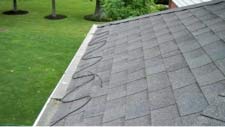At this time of year in Vermont, where Plaster Magic® is based, we see winter in full force. While beautiful, it can also wreak havoc on homes. Many of the plaster repair projects we approach are caused by water damage.
The moisture comes from many sources, but one of the most common is the pesky ice dam: a buildup of ice on a roof’s valleys and eaves that causes leaks.
What Causes Ice Dams?
Ice dams are caused by melting snow. Melted snow, of course, gives you water. The water travels down the roof until it hits the eaves, where it tends to refreeze and cause a buildup of ice and icicles.
Snow melts simply because it is warmer than 32 degrees, or a roof’s pitch is in direct sunlight. In this case, ice dams are not as severe, as it is typically warm enough for the water to drip to the ground.
More severe ice dams occur when a home’s roof is poorly insulated. The warm air from the house melts the snow from the bottom. This can occur even in sub-freezing temperatures. The water travels down to the eaves, which are overhanging the house and thus are not being warmed by inside air, then freezes.
What’s the big deal about ice on your roof? Well, when enough ice builds up, the still-melting snow gets trapped behind the ice, allowing water to seep under shingles or metal paneling. Next comes leaks inside the house. If you have plaster ceilings and walls, they may become saturated and damaged. Hopefully it will never get to this point.
Tips to Prevent Ice Dams
As always, maintenance is the best medicine. Plaster repair should never be necessary with proper maintenance. Here are some tips to prevent ice dams:
- Make sure your attics and/or ceilings are well insulated and ventilated. Not only will this prevent ice dams and costly water damage, but it saves you big money in energy costs over the long run.
- Clear your roof of snow as soon as possible after a snowstorm. The longer you wait, the more opportunity for ice dams to build up.
 Install electric heating coils. Like an electric blanket for your roof, you can zigzag these metal wires along problem areas like eaves and valleys to prevent ice from forming in the first place (see photo at right).
Install electric heating coils. Like an electric blanket for your roof, you can zigzag these metal wires along problem areas like eaves and valleys to prevent ice from forming in the first place (see photo at right).
- Purchase a “roof rake” Most roof rakes have long, retractable handles that let you reach high up the roof and “rake” the snow off. Use common sense and take proper precautions. Try to remove snow evenly, as uneven weight distribution stresses trusses.
- If you don’t feel that you can safely remove snow from the roof yourself, call a contractor. Snow plowing contractors will sometimes include this in their services. Otherwise, general contractors may be able to help.
Be safe and please drop us a line at info@plastermagic.com if you have any more questions about proper wintertime maintenance to prevent water damage.